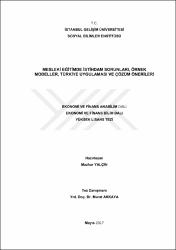| dc.contributor.author | Yalçın, Mazhar | |
| dc.date.accessioned | 2019-01-21T09:22:33Z | |
| dc.date.available | 2019-01-21T09:22:33Z | |
| dc.date.issued | 2017-05-30 | |
| dc.date.submitted | 2017-05-30 | |
| dc.identifier.uri | http://hdl.handle.net/11363/934 | |
| dc.description | Danışman: Murat Akkaya. | en_US |
| dc.description.abstract | İnsanlık tarihi incelendiğinde 18 yy ’la kadar normal bir gelişim gösteren sanayi üretimi 18 yy. ikinci yarısından itibaren sanayi inkılabı etkisiyle büyük bir sıçrama yaşamıştır. Üretimin içine makinenin dahil edilmesiyle arz oranları tarihin hiçbir dönemine kıyaslanmayacak derece artmıştır. İşbölümü ve uzmanlaşmaya dayalı artan üretim ülkeleri yeni pazar ve alanlara yönlendirmiştir. Süreç içerisinde teknolojinin getrmiş olduğu yeniliklere uygun olarak piyasalarını yapılandıran ülkeler değişimin temel öncüsü olarak küresel artan refahtan daha fazla pay almışlardır. Bilgi ve teknik kapasitenin yükseltilip tabana yayılma süreci ile birlikte iktisadi kalkınma da aşamalar oluşmuş, zaman içerisinde iktisadi refah yükselmiş başta gelir düzeyi olmak üzere beşerî sosyal alanların tümünde olumlu değişim yaşanmıştır. Yukarıda kısaca özetlenen gelişim evresi aslına bakılırsa sadece sonuçtur. Asıl sorulması gereken hangi beşerî gelişim aşamalarından sonra buraya gelindiğidir? Gelişmiş ülke ekonomileri incelendiğinde hemen hemen hepsinde görülen temel özellik beşerî sermayeyi değerlendirme biçimleridir. Ekonomik refahın arttırılması, sosyo-kültürel, politik, sosyolojik ve diğer tüm alanlarda yaşanan ilerlemenin doğru ve öngürülü eğitim politikaları neticesinde elde edildiği görülmektedir. Beşerî sermayenin çağın fehmi ve idrakinde yetiştirilmesi, insan hayatının ilgili tüm alanlarıyla müşterek eğitim politika ve uygulamalarıyla mümkün olabileceği görülmektedir. Artan uluslararası rekabet, iş piyasalarının değişim ve dönüşümü neticesinde yeni teknik bilgi ve teknolojik yeniliklerin kolaylaştırıcı yönü beşerî sermayenin niteliğini daha da önemli hale getirmiştir. Emek yoğun üretim anlayışından sermaye yoğun üretime geçişle beraber iş piyasalarının nitelikli işgücü ihtiyacı artmıştır. Artan bu nitelikli işgücü ihtiyacının temini amacıyla ülkeler geleneksel mesleki eğitim modellerini revize ederek modern teknik bilgi ve becerilerle destekli okul ve kurum modeli geliştirmişlerdir. Ülkemizde bu değişim ve dönüşüme uygun olarak süreç içerisinde mesleki eğitim modelinde değişime gitmiş; artan nitelikli işgücü ihtiyacına uygun olarak bu model üzerinde iyileştirmeler yapmıştır. İş piyasanın artan nitelikli işgücü ihtiyacı, ülkelerin küresel rekabet edebilirlik düzeyinin arttırılması, süreç içerisinde birikimli artan oranlı işsizlikler nedeniyle mesleki ve teknik eğitimde de model arayışları sürekli kılınmıştır. Temelde üretim tekniklerinde yaşanan değişim ve dönüşüme bağlı olarak aktif nüfus içerisinde bulunması rağmen niteliği nedeniyle iş piyasasına entegre olamayan işgücünün yaşamış olduğu işsizlik probleminin önüne geçmek, işgücünün yapısal sorununu çözerek meslek edinmesinde kolaylık sağlamak amacıyla mesleki eğitim öncülenmektedir. Ülkemizin artan nitelikli işgücünü temin ve işgücü piyasamızın yaşadığı yapısal sorunların irdelenip güncel gelişmiş modeller üzerinden işsizliğe çözüm arayışları bu tezin ana fikridir. İşsizlik probleminin yarattığı sosyal, siyasal, iktisadi olumsuz etkilerden yola çıkarak genç nüfusun yaşadığı işsizlik problemine mesleki eğitim modeli içerisinde çözüm aranmıştır. İyi örneklerden hareketle istihdama yönelik mesleki eğitim modelinin nasıl olması gerektiği üzerinde çalışılmıştır. | en_US |
| dc.description.abstract | When we look at the history of humanity, it is easy to realise that there had been a dramatic change in industrial manufacturing by the impact of the technological development and industrial revoulution. The use of machinery accelerated the supply of good enourmously which has not withessed anytime before. The mass production based upon division of labour and specialisation made nations to find new markets. The nations, which have reforemed their markets in accordance with technological developments, has benefited from global wealth more than other nations. Technical capacity and knowledge has sharply increased the wealth of those nations. In fact, the development process that briefly explained above is actually the result. The most significant question that must be asked is what kind of human development processes have played in this regard. When it is investigated, the developed country economies are mostly categorised in accordance with how they use the human capital. Economic wealth and other developments (such as socio-cultural, political and sociological) in those counrties are mostly shaped by visionary education policies. The development of human capital is only possible with education policies that related to all the areas of life. İncreased international competition by the role of technical knowledge and other advances in technology made the haman capital more crucial. The need for qualified labour has increased along with the change from labour-intensive production to the capital-intensive production. For this need, various countries revised their traditional vocational education systems and developed a new model based upon modern and institions. In this regard, our country, Turkey, has also developed a new vocational education model, and revised its model in accordence with the changes with respect to increasing need of qualified labour force. The need of qualified labour force of the market has played a key role in increasing the global competitivity of nations and make the search of a suitable model in terms of vocational education perennial. With vocational educution, it is aimed at fixing the structural problems of labour force and to reduce the unemployment level of youth population that is grounded in the changes and developments related to the means of production. The supply of qualified labour and the search for a solution to the structural problems of our labour market constitutes the main purpose of this thesis. In this study, it is searched for a solution to youth unemployment in respect to vocational education by looking at social, political and economic problems based upon unemployment. It is examined how to develop a vocational education model In light of the good examples. | en_US |
| dc.language.iso | tur | en_US |
| dc.publisher | İstanbul Gelişim Üniversitesi Sosyal Bilimler Enstitüsü | en_US |
| dc.rights | info:eu-repo/semantics/openAccess | en_US |
| dc.rights | Attribution-NonCommercial-NoDerivs 3.0 United States | * |
| dc.rights.uri | http://creativecommons.org/licenses/by-nc-nd/3.0/us/ | * |
| dc.subject | Research Subject Categories::SOCIAL SCIENCES | en_US |
| dc.subject | Research Subject Categories::SOCIAL SCIENCES::Social sciences::Education | en_US |
| dc.title | Mesleki eğitimde istihdam sorunları, örnek modeller, Türkiye uygulaması ve çözüm önerileri | en_US |
| dc.title.alternative | Employment problems i̇n vocational education, sample models, Turkey application and solution proposal | en_US |
| dc.type | masterThesis | en_US |
| dc.department | İstanbul Gelişim Üniversitesi | en_US |
| dc.relation.publicationcategory | Tez | en_US |



















